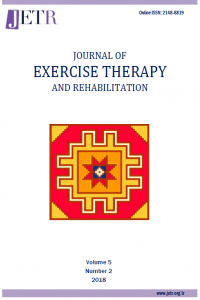Öz
Amaç: Bu çalışmanın amacı, rehabilitasyon programına motivasyonu değerlendiren Pediatrik Motivasyon Ölçeği’nin (PMÖ) Türkçe geçerlik ve güvenirliğini incelemekti.
Yöntem: Çalışmaya, 8-18 yaş arasında, kronik engelli 62 (30 kız, 32 erkek) çocuk dâhil edildi. Çocukların sosyo-demografik özellikleri, araştırmacı tarafından hazırlanan bir form ile sorgulandı. Çocukların rehabilitasyona motivasyonu PMÖ ve Vizüel Analog Skalası (VAS) ile değerlendirildi. Ölçeğin geçerliliğinin belirlenebilmesi için PMÖ ile VAS arasındaki korelasyon incelendi. İç tutarlılığın belirlenebilmesi için Cronbach Alfa değeri hesaplandı. Test-tekrar test güvenilirliğinin belirlenebilmesi için rastgele 15 çocuğa ilk değerlendirmeden iki hafta sonra ikinci değerlendirmeler yapıldı ve Sınıf içi Korelasyon Katsayısı (ICC) değeri hesaplandı.
Bulgular: PMÖ ve VAS arasında pozitif yönde iyi düzeyde bir korelasyon olduğu belirlendi (r=0,713, p<0,001). PMÖ’nün iç tutarlılığı yüksekti (Cronbach Alfa: 0,827). Test-tekrar test güvenilirliği çok yüksek (ICC: 0,960) olarak bulundu.
Tartışma: Çalışmanın sonuçları, PMÖ’nün, rehabilitasyon programına katılan kronik engelli çocukların rehabilitasyona katılım konusundaki motivasyonu değerlendirmek için kullanılabilecek geçerli ve güvenilir bir ölçek olduğunu ortaya çıkardı.
Anahtar Kelimeler
Kaynakça
- 1. Majnemer A. Importance of motivation to children's participation: A motivation to change. Phys Occup Ther Pediatr. 2011;31:1-3.
- 2. Miller L, Ziviani J, Ware RS, et al. Does Context Matter? Mastery Motivation and Therapy Engagement of Children with Cerebral Palsy. Phys Occup Ther Pediatr. 2016;36:155-170.
- 3. Tatla SK, Jarus T, Virji-Babul N, et al. The development of the Pediatric Motivation Scale for rehabilitation. Can J Occup Ther. 2015;82:93-105.
- 4. Miller L, Marnane K, Ziviani J, et al. The Dimensions of Mastery Questionnaire in school-aged children with congenital hemiplegia: test-retest reproducibility and parent-child concordance. Phys Occup Ther Pediatr. 2014;34:168-184.
- 5. Gilmore L, Cuskelly M. Observational assessment and maternal reports of motivation in children and adolescents with Down syndrome. Am J Intellect Dev Disabil. 2011;116:153-164.
- 6. Miller L, Ziviani J, Ware RS, et al. Mastery motivation in children with congenital hemiplegia: individual and environmental associations. Dev Med Child Neurol. 2014;56:267-274.
- 7. Sandlund M, Dock K, Häger CK, et al. Motion interactive video games in home training for children with cerebral palsy: parents’ perceptions. Disabil Rehabil. 2012;34:925-933.
- 8. Meyns P, Roman de Mettelinge T, van der Spank J, et al. Motivation in pediatric motor rehabilitation: A systematic search of the literature using the selfdetermination theory as a conceptual framework. Dev Neurorehabil. 2017 Mar 9:1-20.
- 9. Guillemin F, Bombardier C, Beaton D. Cross-cultural adaptation of health-related quality of life measures: literature review and proposed guidelines. J Clin Epidemiol. 1993;46:1417-1432.
- 10. Kahraman T, Genc A, Goz E. The Nordic Musculoskeletal Questionnaire: cross-cultural adaptation into Turkish assessing its psychometric properties. Disabil Rehabil. 2016;38:2153-2160.
- 11. Mesquita CC, Ribeiro JC, Moreira P. Portuguese version of the standardized Nordic musculoskeletal questionnaire: cross cultural and reliability. J Public Health. 2010;18:461-466.
- 12. Ottenbacher KJ, Msall ME, Lyon N, et al. The WeeFIM instrument: its utility in detecting change in children with developmental disabilities. Arch Phys Med Rehabil. 2000;81:1317-1326.
- 13. Souza ESd, Magalhães LdC. Motor and functional development in infants born preterm and full term: influence of biological and environmental risk factors. Rev Paul Pediatr. 2012;30:462-470.
- 14. Wong V, Wong S, Chan K, et al. Functional Independence Measure (WeeFIM) for Chinese children: Hong Kong Cohort. Pediatrics. 2002;109:E36.
- 15. Ryan RM, Deci EL. Intrinsic and Extrinsic Motivations: Classic Definitions and New Directions. Contemp Educ Psychol. 2000;25:54-67.
- 16. Ziviani J. Occupational performance: a case for selfdetermination. Aust Occup Ther J. 2015;62:393-400.
- 17. Levac D. How Can Therapists Enhance Children's Engagement in Home-Based Rehabilitation Interventions? Phys Occup Ther Pediatr. 2016;36:359-362.
- 18. Couper MP, Tourangeau R, Conrad FG, et al. Evaluating the effectiveness of visual analog scales - A web experiment. Soc Sci Comput Rev. 2006;24:227-245.
- 19. Bond A, Lader M. The use of analogue scales in rating subjective feelings. Psychology and Psychotherapy: Theory, Research and Practice. 1974;47:211-218.
- 20. Heller GZ, Manuguerra M, Chow R. How to analyze the Visual Analogue Scale: Myths, truths and clinical relevance. Scand J Pain. 2016;13:67-75.
- 21. Marx RG, Menezes A, Horovitz L, et al. A comparison of two time intervals for test-retest reliability of health status instruments. J Clin Epidemiol. 2003;56:730-735.
- 22. Majnemer A, Shevell M, Law M, et al. Level of motivation in mastering challenging tasks in children with cerebral palsy. Dev Med Child Neurol. 2010;52:1120-1126.
- 23. King G, Chiarello LA, Thompson L, et al. Development of an observational measure of therapy engagement for pediatric rehabilitation. Disabil Rehabil. 2017 Sep 10:1-12.
- 24. Jannink MJ, van der Wilden GJ, Navis DW, et al. A low-cost video game applied for training of upper extremity function in children with cerebral palsy: a pilot study. Cyberpsychol Behav. 2008;11(1):27-32.
- 25. Bingham PM, Calhoun B. Digital Posturography Games Correlate with Gross Motor Function in Children with Cerebral Palsy. Games Health J. 2015;4:145-148.
- 26. Sharan D, Ajeesh PS, Rameshkumar R, et al. Virtual reality based therapy for post operative rehabilitation of children with cerebral palsy. 2012;41 Suppl 1:3612-3615.
- 27. Bryanton C, Bosse J, Brien M, et al. Feasibility, motivation, and selective motor control: virtual reality compared to conventional home exercise in children with cerebral palsy. Cyberpsychol Behav. 2006;9:123-128.
Ayrıntılar
| Birincil Dil | Türkçe |
|---|---|
| Bölüm | Makaleler |
| Yazarlar | |
| Yayımlanma Tarihi | 16 Temmuz 2018 |
| Gönderilme Tarihi | 11 Ocak 2018 |
| Yayımlandığı Sayı | Yıl 2018 Cilt: 5 Sayı: 2 |

